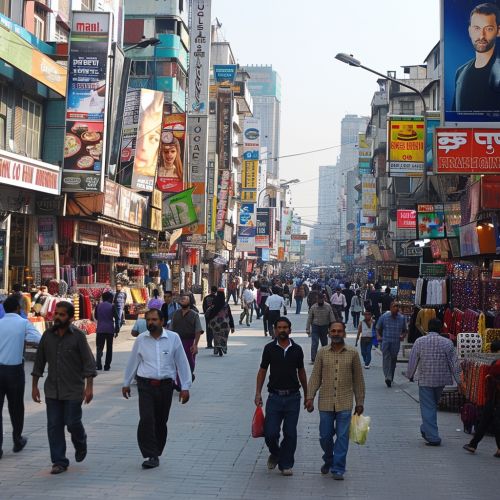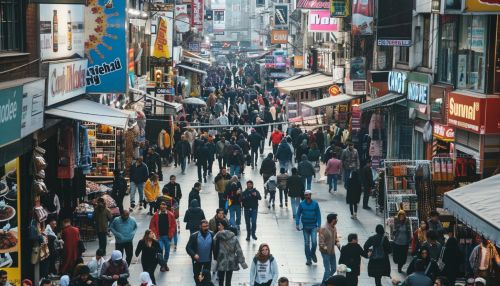Cultural diffusion: Difference between revisions
(Created page with "== Introduction == Cultural diffusion is the process by which cultural elements, such as ideas, styles, religions, technologies, languages, and social norms, spread from one society or cultural group to another. This phenomenon is a fundamental aspect of human interaction and has played a crucial role in shaping civilizations throughout history. Cultural diffusion can occur through various mechanisms, including trade, migration, warfare, and communication. Understanding...") |
No edit summary |
||
| Line 44: | Line 44: | ||
In the contemporary world, globalization has become a major driver of cultural diffusion. The interconnectedness of economies, societies, and cultures through trade, communication, and travel has led to the widespread exchange of cultural elements. For example, the global popularity of [[fast food]] chains like [[McDonald's]] and [[Starbucks]] illustrates how cultural products can spread rapidly across the world. | In the contemporary world, globalization has become a major driver of cultural diffusion. The interconnectedness of economies, societies, and cultures through trade, communication, and travel has led to the widespread exchange of cultural elements. For example, the global popularity of [[fast food]] chains like [[McDonald's]] and [[Starbucks]] illustrates how cultural products can spread rapidly across the world. | ||
[[Image:Detail-92461.jpg|thumb|center|A bustling city street with people of diverse backgrounds, various shops, and advertisements for international brands.|class=only_on_mobile]] | |||
[[Image:Detail-92462.jpg|thumb|center|A bustling city street with people of diverse backgrounds, various shops, and advertisements for international brands.|class=only_on_desktop]] | |||
=== The Internet and Social Media === | === The Internet and Social Media === | ||
Latest revision as of 10:11, 14 June 2024
Introduction
Cultural diffusion is the process by which cultural elements, such as ideas, styles, religions, technologies, languages, and social norms, spread from one society or cultural group to another. This phenomenon is a fundamental aspect of human interaction and has played a crucial role in shaping civilizations throughout history. Cultural diffusion can occur through various mechanisms, including trade, migration, warfare, and communication. Understanding cultural diffusion is essential for comprehending how cultures evolve and influence each other over time.
Mechanisms of Cultural Diffusion
Trade
Trade has historically been one of the primary mechanisms of cultural diffusion. Through the exchange of goods, people from different cultures come into contact, leading to the sharing of ideas, technologies, and customs. The Silk Road is a notable example of how trade facilitated cultural diffusion between the East and the West. Along this ancient network of trade routes, merchants, travelers, and scholars exchanged not only goods like silk, spices, and precious metals but also knowledge, religious beliefs, and artistic styles.
Migration
Migration involves the movement of people from one region to another, often resulting in the blending of cultures. When people migrate, they bring their cultural practices, languages, and traditions with them, which can influence the host society. The Great Migration in the United States during the early 20th century, where millions of African Americans moved from the rural South to urban areas in the North, is an example of how migration can lead to significant cultural diffusion.
Warfare
Warfare has also been a significant driver of cultural diffusion. Conquering armies and empires often impose their culture on the subjugated populations, while also adopting elements of the conquered cultures. The Roman Empire is a prime example of this phenomenon. As the Romans expanded their territory, they assimilated various aspects of the cultures they encountered, such as Greek art, religion, and philosophy, which in turn influenced Roman culture.
Communication
Advancements in communication technologies have greatly accelerated cultural diffusion in the modern era. The invention of the printing press, the telegraph, the telephone, and the internet has made it easier for people to share information and ideas across vast distances. The Internet has particularly revolutionized cultural diffusion by enabling instant communication and access to a vast array of cultural content from around the world.
Types of Cultural Diffusion
Direct Diffusion
Direct diffusion occurs when two cultures are in close contact and directly exchange cultural elements. This type of diffusion often happens through trade, intermarriage, or direct communication. For example, the spread of Buddhism from India to neighboring countries like China, Japan, and Korea is an instance of direct diffusion.
Indirect Diffusion
Indirect diffusion happens when cultural elements are passed from one culture to another through a third party. This type of diffusion is common in cases where there is no direct contact between the original and recipient cultures. An example of indirect diffusion is the spread of Islamic architecture to Europe through the Moors in Spain.
Forced Diffusion
Forced diffusion occurs when one culture imposes its cultural elements on another through conquest, colonization, or other forms of domination. The European colonization of the Americas led to the forced diffusion of European languages, religions, and social structures onto the indigenous populations.
Historical Examples of Cultural Diffusion
The Hellenistic Period
The Hellenistic period, following the conquests of Alexander the Great, is a classic example of cultural diffusion. Alexander's empire stretched from Greece to Egypt and into the Indian subcontinent, creating a melting pot of cultures. Greek language, art, and philosophy spread throughout the empire, while elements of Persian, Egyptian, and Indian cultures were incorporated into Greek culture.
The Spread of Islam
The spread of Islam from the 7th century onwards is another significant example of cultural diffusion. As Islamic empires expanded, they brought with them not only the religion of Islam but also advancements in science, medicine, mathematics, and literature. The Islamic Golden Age saw the synthesis of knowledge from various cultures, including Greek, Persian, Indian, and Chinese, which were then transmitted to Europe and influenced the Renaissance.
The Columbian Exchange
The Columbian Exchange refers to the widespread transfer of plants, animals, culture, human populations, technology, and ideas between the Americas and the Old World following the voyages of Christopher Columbus. This exchange had profound effects on the global population and economy, leading to significant cultural diffusion. For instance, the introduction of New World crops like potatoes and maize to Europe and the introduction of Old World livestock like horses and cattle to the Americas transformed societies on both sides of the Atlantic.
Modern Examples of Cultural Diffusion
Globalization
In the contemporary world, globalization has become a major driver of cultural diffusion. The interconnectedness of economies, societies, and cultures through trade, communication, and travel has led to the widespread exchange of cultural elements. For example, the global popularity of fast food chains like McDonald's and Starbucks illustrates how cultural products can spread rapidly across the world.


The Internet and Social Media
The advent of the internet and social media platforms has further accelerated cultural diffusion. Websites like YouTube, Facebook, and Twitter allow users to share content and ideas instantaneously, leading to the rapid spread of cultural trends, memes, and movements. The global reach of these platforms means that cultural elements can quickly gain international popularity, as seen with the worldwide phenomenon of K-pop.
Cultural Festivals
Cultural festivals and events also play a significant role in modern cultural diffusion. Events like the Olympic Games, World Expos, and international film festivals bring together people from diverse cultural backgrounds, facilitating the exchange of cultural practices and ideas. These events provide a platform for showcasing and celebrating cultural diversity, leading to greater awareness and appreciation of different cultures.
Factors Influencing Cultural Diffusion
Technological Advancements
Technological advancements have a profound impact on the rate and extent of cultural diffusion. Innovations in transportation, such as the steam engine, the automobile, and the airplane, have made it easier for people to travel and interact with different cultures. Similarly, advancements in communication technologies, from the printing press to the internet, have facilitated the rapid spread of cultural elements.
Economic Factors
Economic factors, such as trade and commerce, play a crucial role in cultural diffusion. Societies that engage in extensive trade are more likely to experience cultural exchange. Economic globalization, characterized by the integration of national economies into the global economy, has led to increased cultural diffusion as goods, services, and people move across borders.
Political Factors
Political factors, including policies, treaties, and alliances, can influence cultural diffusion. Governments may promote cultural exchange through diplomatic efforts, cultural agreements, and international cooperation. Conversely, political barriers, such as restrictive immigration policies or trade embargoes, can hinder cultural diffusion.
Social and Cultural Factors
Social and cultural factors, such as language, religion, and social norms, also affect cultural diffusion. Shared languages and religious beliefs can facilitate cultural exchange, while cultural barriers, such as ethnocentrism or xenophobia, can impede it. The openness of a society to new ideas and cultural practices can significantly influence the extent of cultural diffusion.
Impacts of Cultural Diffusion
Positive Impacts
Cultural diffusion can have numerous positive impacts, including the enrichment of cultures through the exchange of ideas, technologies, and practices. It can lead to greater cultural diversity, innovation, and progress. For example, the diffusion of scientific knowledge and technological advancements has contributed to global development and improved quality of life.
Negative Impacts
However, cultural diffusion can also have negative impacts. It can lead to cultural homogenization, where unique cultural identities are diminished or lost. The dominance of certain cultures, often through processes like cultural imperialism, can result in the marginalization of minority cultures. Additionally, the rapid spread of cultural elements can sometimes lead to cultural misunderstandings or conflicts.
Theories of Cultural Diffusion
Diffusionism
Diffusionism is a theoretical perspective that emphasizes the role of cultural diffusion in the development of societies. Early diffusionist theories, such as those proposed by Grafton Elliot Smith and William James Perry, suggested that major cultural innovations originated in a few key centers and spread to other societies. While these early theories have been criticized for their simplistic and Eurocentric views, they laid the groundwork for understanding the importance of cultural diffusion.
Cultural Relativism
Cultural relativism, a concept popularized by anthropologists like Franz Boas, argues that cultures should be understood in their own context rather than judged by the standards of another culture. This perspective highlights the importance of recognizing the diversity of cultural practices and the complex ways in which cultures influence each other through diffusion.
World-Systems Theory
World-systems theory, developed by sociologist Immanuel Wallerstein, provides a macro-level analysis of cultural diffusion within the context of global economic systems. According to this theory, the world is divided into core, semi-peripheral, and peripheral regions, with cultural diffusion occurring as a result of economic and political interactions between these regions. The theory emphasizes the unequal power dynamics that can shape cultural exchange.
Conclusion
Cultural diffusion is a multifaceted and dynamic process that has played a crucial role in shaping human history and societies. Through mechanisms such as trade, migration, warfare, and communication, cultural elements are exchanged and integrated, leading to the evolution and enrichment of cultures. While cultural diffusion can have both positive and negative impacts, understanding its complexities is essential for appreciating the interconnectedness of human cultures and the ongoing processes of cultural change.
